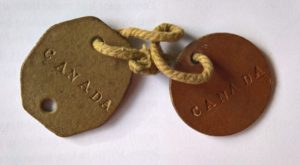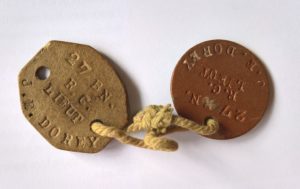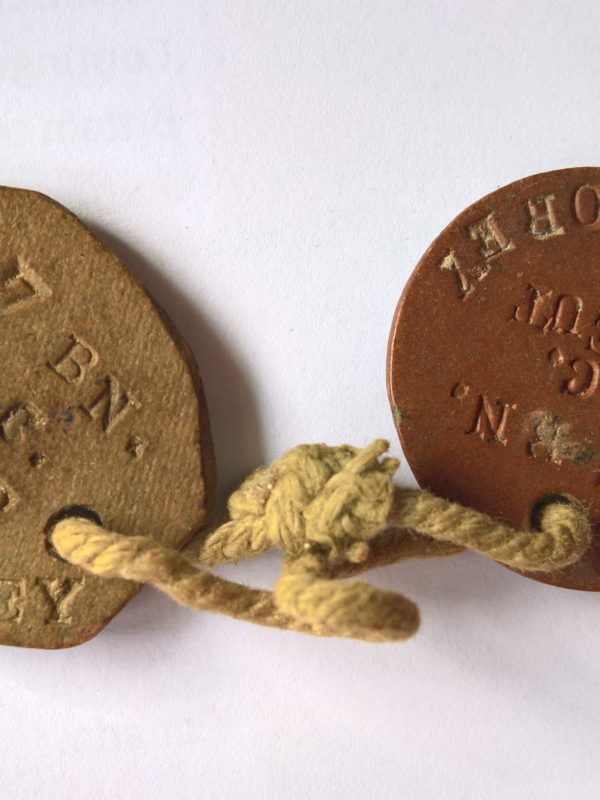This is a short piece which I wrote for a conflict archaeology course about identity tags as memory objects relating to a recent modern conflict. The First World War identity tags are my grandfather’s .
To describe them, I would start by saying that each British and Empire soldier had two tags. These tags could be made of metal or made of fibre board. These are of the latter type. One is a lozenge in shape and originally would have been a greenish colour, and the other, a red disc.
A string threaded through the second hole of the green tag and tied to make a loop, allowed them to be worn around the soldier’s neck. The red disc was attached to the green one by a short loop of string. The longer loop is now missing, but the shorter loop seems original based on other photographs of similar tags.

Each disc would record the name, service number, unit and religion of a soldier and the intention was that if a soldier was killed, he would be buried with the green tag and the red one would be removed and used as proof of death and to create a casualty record. In that way, as an identity tag was buried with the casualty, if the body was exhumed for reburial, it would be possible to properly re-identify the body.
Equally, if a body was found and it couldn’t be buried, the red disc was removed in the same way as proof of death.
The problem with this system was twofold. Firstly, the fibre discs would ultimately rot and so a body buried for a long time, would not be capable of being identified. This is particularly the case if bodies were lost on the battlefield and only discovered many years later, which is usually the case with bodies found now. The second problem was that owing to the nature of injuries sustained during industrial mechanised warfare, which often meant that bodies suffered horrendous injuries and dismemberment, the flimsy strings securing the tags were broken and blown away, meaning that the body remains were unidentifiable.
There was also a difference between officers and other ranks tags. Officers identity tags did not have a service number because they didn’t have one allocated! (Equally NCOs and privates didn’t get a rank on their tags). It seems that under the class system of the time, officers were known by their rank rather than the number which other ranks were all given.
As regards my grandfather’s identity tags, they record his unit as the 27th Battalion, Canadian Infantry and his rank as Lieutenant.
I have wondered why he kept them. Slightly grubby items which look as if they still have a bit of ingrained dirt!
He would have worn them continuously for over four years (that was a requirement of military service although these must have been a second set, as he started as an enlisted volunteer). They were therefore something which was a constant reminder that he was a soldier before anything else no matter whether he was in uniform or not.
They also were a manifestation of the environment in which he was living – that of life and death. One minute he was alive with both green and red tags. The next, his red blood would be shed, and like the loss of his red disc, it would signify that he had lost his life. He had had close shaves – at least three times, he had been hit by bullets or shrapnel requiring treatment. Perhaps it was for that reason, he couldn’t risk abandoning the talisman which had survived with him throughout the war, even through the war was now over. Better keep them just in case for that short piece of string meant that he was alive!
Finally, it is only recently having done a little more research about identity tags, that I have realised that my grandfather’s religion is stated on them as Roman Catholic. This is very surprising! For a start, he came from a Methodist family and is even recorded on the Roll of Service in the local Methodist chapel. Upon enlistment, he had stated his religion was Church of England which again is odd in that “METH” was a recognised option. I wonder whether it was his like of an occasion drink which would have been inconsistent with Methodist abstention? I don’t believe that my grandfather was at all religious in later life although he did become a prominent and active Mason.

So how did he end up as Roman Catholic according to his tags?
My grandfather really didn’t speak about his experiences of the war and therefore I have no idea other than to guess that it could have been something to do with his very dry and great sense of humour. He loved playing tricks on others and I am quite sure that sometimes others might have been quite cross with him before they realised the joke. It wouldn’t surprise me that he had made a flippant comment about his religion at the time, made for some dramatic and/or humorous effect, but which he then couldn’t retract without giving offence and so he became Roman Catholic! I would have loved to ask him!
To me, the tags are a very personal possession of my grandfather from a period of his life where it is virtually impossible to fully comprehend what he went through, saw and experienced.

